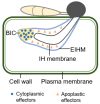Recent Advances in Effector Research of Magnaporthe oryzae
- PMID: 38002332
- PMCID: PMC10669146
- DOI: 10.3390/biom13111650
Recent Advances in Effector Research of Magnaporthe oryzae
Abstract
Recalcitrant rice blast disease is caused by Magnaporthe oryzae, which has a significant negative economic reverberation on crop productivity. In order to induce the disease onto the host, M. oryzae positively generates many types of small secreted proteins, here named as effectors, to manipulate the host cell for the purpose of stimulating pathogenic infection. In M. oryzae, by engaging with specific receptors on the cell surface, effectors activate signaling channels which control an array of cellular activities, such as proliferation, differentiation and apoptosis. The most recent research on effector identification, classification, function, secretion, and control mechanism has been compiled in this review. In addition, the article also discusses directions and challenges for future research into an effector in M. oryzae.
Keywords: M. oryzae; classification; effectors; function; regulation mechanism; secretion.
Conflict of interest statement
The authors declare no conflict of interest.
Figures




Similar articles
-
Effector-triggered susceptibility by the rice blast fungus Magnaporthe oryzae.New Phytol. 2024 Feb;241(3):1007-1020. doi: 10.1111/nph.19446. Epub 2023 Dec 10. New Phytol. 2024. PMID: 38073141 Review.
-
A nonclassically secreted effector of Magnaporthe oryzae targets host nuclei and plays important roles in fungal growth and plant infection.Mol Plant Pathol. 2023 Sep;24(9):1093-1106. doi: 10.1111/mpp.13356. Epub 2023 Jun 12. Mol Plant Pathol. 2023. PMID: 37306516 Free PMC article.
-
Screening of Candidate Effectors from Magnaporthe oryzae by In Vitro Secretomic Analysis.Int J Mol Sci. 2023 Feb 6;24(4):3189. doi: 10.3390/ijms24043189. Int J Mol Sci. 2023. PMID: 36834598 Free PMC article.
-
Plant Peroxisome-Targeting Effector MoPtep1 Is Required for the Virulence of Magnaporthe oryzae.Int J Mol Sci. 2022 Feb 24;23(5):2515. doi: 10.3390/ijms23052515. Int J Mol Sci. 2022. PMID: 35269662 Free PMC article.
-
Investigating the cell biology of plant infection by the rice blast fungus Magnaporthe oryzae.Curr Opin Microbiol. 2016 Dec;34:147-153. doi: 10.1016/j.mib.2016.10.001. Epub 2016 Nov 3. Curr Opin Microbiol. 2016. PMID: 27816794 Review.
Cited by
-
Status on Genetic Resistance to Rice Blast Disease in the Post-Genomic Era.Plants (Basel). 2025 Mar 5;14(5):807. doi: 10.3390/plants14050807. Plants (Basel). 2025. PMID: 40094775 Free PMC article. Review.
References
Publication types
MeSH terms
Substances
Supplementary concepts
Grants and funding
LinkOut - more resources
Full Text Sources
Research Materials

